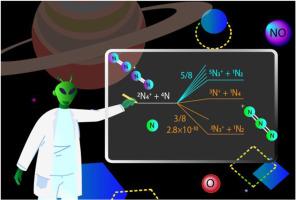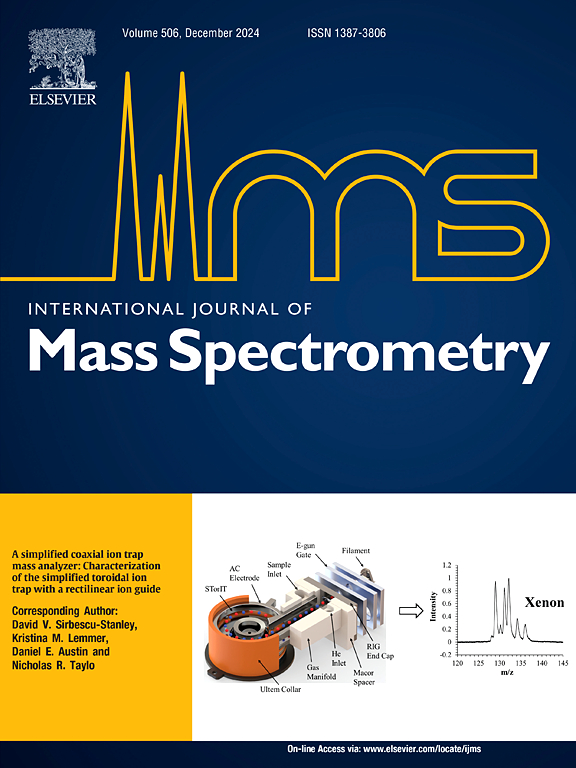Kinetics of N3+ and N4+ with N(4S), O(3P), and NO
IF 1.7
3区 化学
Q3 PHYSICS, ATOMIC, MOLECULAR & CHEMICAL
引用次数: 0
Abstract
Kinetics of the reactions of N3+ and N4+ with N(4S) and O(3P) are measured at room temperature using a flowing afterglow-selected ion flow tube apparatus. Oxygen atoms are produced by titrating NO against nitrogen atoms formed from a microwave discharge of N2. The reaction rate constants are generally well-described by assuming strict spin-conservation along with Langevin capture kinetics. N3+ + N occurs with k = 1.8 × 10−10 cm3 s−1, spin state counting indicates both doublet and quartet states of N2+ are formed. N4+ + N occurs with k = 2.2 × 10−10 cm3 s−1, yielding exclusively N3+. The N3+ + O reaction occurs with k = 2.5 × 10−10 cm3 s−1, yielding significant amounts of NO+ and N2+ products. N4+ + O, the only of these reactions without any spin-constraint, is the only reaction to occur near the Langevin capture rate with k = 5.6 × 10−10 cm3 s−1. The major product of the N4+ + O reaction is charge transfer to yield O+ (k = 4.1 × 10−10 cm3 s−1) with N2O+ (k = 7.7 × 10−11 cm3s−1) and probably NO + formed as minor products. The reaction of N4+ + NO minimally occurs with k < 6.5 × 10−12 cm3 s−1. A novel method of assessing uncertainties in rate constants derived from complicated chemical reaction networks is presented, yielding probability density curves as a function of each partial rate constant. The analysis obviates the need of assuming experimental errors of the rate constants are normally distributed.

N3+ 和 N4+ 与 N(4S)、O(3P) 和 NO 的动力学关系
使用流动的余辉选择离子流管仪器在室温下测量了 N3+ 和 N4+ 与 N(4S) 和 O(3P) 反应的动力学。氧原子是通过将 NO 与 N2 微波放电形成的氮原子进行滴定而产生的。通过假设严格的自旋守恒和朗格文捕获动力学,反应速率常数一般都能得到很好的描述。N3+ + N 的反应速率为 k = 1.8 × 10-10 cm3 s-1,自旋态计数表明 N2+ 的双态和四态均已形成。N4+ + N 的反应速度为 k = 2.2 × 10-10 cm3 s-1,生成的完全是 N3+。N3+ + O 反应在 k = 2.5 × 10-10 cm3 s-1 时发生,生成大量 NO+ 和 N2+ 产物。N4+ + O 是这些反应中唯一没有自旋约束的反应,也是唯一以 k = 5.6 × 10-10 cm3 s-1 发生在朗格文捕获率附近的反应。N4+ + O 反应的主要产物是电荷转移产生的 O+(k = 4.1 × 10-10 cm3 s-1),次要产物是 N2O+(k = 7.7 × 10-11 cm3 s-1)和可能形成的 NO+。N4+ + NO 的反应以 k < 6.5 × 10-12 cm3 s-1 的最小值发生。本文提出了一种新方法,用于评估从复杂化学反应网络中得出的速率常数的不确定性,得出了作为各部分速率常数函数的概率密度曲线。这种分析方法无需假设速率常数的实验误差呈正态分布。
本文章由计算机程序翻译,如有差异,请以英文原文为准。
求助全文
约1分钟内获得全文
求助全文
来源期刊
CiteScore
3.60
自引率
5.60%
发文量
145
审稿时长
71 days
期刊介绍:
The journal invites papers that advance the field of mass spectrometry by exploring fundamental aspects of ion processes using both the experimental and theoretical approaches, developing new instrumentation and experimental strategies for chemical analysis using mass spectrometry, developing new computational strategies for data interpretation and integration, reporting new applications of mass spectrometry and hyphenated techniques in biology, chemistry, geology, and physics.
Papers, in which standard mass spectrometry techniques are used for analysis will not be considered.
IJMS publishes full-length articles, short communications, reviews, and feature articles including young scientist features.

 求助内容:
求助内容: 应助结果提醒方式:
应助结果提醒方式:


